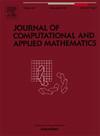退化/奇异抛物型方程点向可控性的极小时间及其b样条数值结果
IF 2.6
2区 数学
Q1 MATHEMATICS, APPLIED
Journal of Computational and Applied Mathematics
Pub Date : 2025-07-11
DOI:10.1016/j.cam.2025.116892
引用次数: 0
摘要
本文的目的是分析一维退化/奇异抛物型方程的点向可控性。证明了近似可控性和零可控性的条件。此外,给出了一种基于b样条的数值模拟方法,其中状态和控制都用b样条基函数表示。数值计算结果与理论计算结果吻合。本文章由计算机程序翻译,如有差异,请以英文原文为准。
Minimal time of the pointwise controllability for a degenerate/singular parabolic equation and related numerical results via B-splines
The goal of this paper is to analyze the pointwise controllability properties of a one-dimensional degenerate/singular parabolic equation. We prove the conditions that characterize approximate and null controllability. Besides, a numerical simulation based on B-splines is provided, in which both the state and the control are represented in terms of B-spline basis functions. The numerical results obtained match the theoretical ones.
求助全文
通过发布文献求助,成功后即可免费获取论文全文。
去求助
来源期刊
CiteScore
5.40
自引率
4.20%
发文量
437
审稿时长
3.0 months
期刊介绍:
The Journal of Computational and Applied Mathematics publishes original papers of high scientific value in all areas of computational and applied mathematics. The main interest of the Journal is in papers that describe and analyze new computational techniques for solving scientific or engineering problems. Also the improved analysis, including the effectiveness and applicability, of existing methods and algorithms is of importance. The computational efficiency (e.g. the convergence, stability, accuracy, ...) should be proved and illustrated by nontrivial numerical examples. Papers describing only variants of existing methods, without adding significant new computational properties are not of interest.
The audience consists of: applied mathematicians, numerical analysts, computational scientists and engineers.

 求助内容:
求助内容: 应助结果提醒方式:
应助结果提醒方式:


